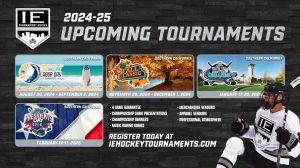Bobcats place significant emphasis on developing goaltenders

As someone who has played and coached hockey at nearly every level, from Mites to the pros, Ron Filion knows just how challenging it can be to properly train goalies.
The position is so different from any other on the ice, and requires not only specialized skills and training, but also a mental approach that is unlike that required of athletes in any other sport. It’s because of the unique demands of the position that Filion and the Arizona Bobcats place a special emphasis on goalie training.
With two former professional goalies – Pat Conacher and Leeor Shtrom – on the Bobcats coaching staff, Filion feels the Bobcats are uniquely positioned to prepare young netminders to build a solid foundation of skills and set themselves up for long-term success.
“There is more than just skill and skating – it is a position that requires a lot of focus, athleticism, mental toughness and more,” said Filion, the Bobcats’ hockey director. “It is the most important position for team success, and we’re proud to have two former professionals leading the way for our young goalies.”
 Conacher said that he and Shtrom split up the duties of coaching goalies equally with the Bobcats, and the fact that they share the same beliefs on how best to develop them has been a big factor in the successes they have experienced.
Conacher said that he and Shtrom split up the duties of coaching goalies equally with the Bobcats, and the fact that they share the same beliefs on how best to develop them has been a big factor in the successes they have experienced.
“When it comes to goaltending, I think Leeor and I have the same philosophies,” Conacher said. “Each goalie coach has his own ideas and thoughts on how to apply them. It’s all the same concepts, but the biggest difference in developing young goalies is how you relate to each kid, and Leeor and I are on the same page in that respect.”
The skills taught to goalies at the youngest levels are relatively simple, but with each new age group comes more detail.
Early on, Conacher and Shtrom believe that all kids should play every position, so they learn to skate well and master some of the stickhandling skills that they might not get if they were to exclusively play goalie from the start.
“I think around 10 years old is the appropriate time for kids to begin specializing in goaltending if that’s what they want to do,” Conacher said. “Kids can move faster through the training if they start by becoming confident skaters. If you go right into playing goalie as a young kid, I think you lose a lot of opportunities for athletic development that you would pick up from playing forward or defense – in terms of hand-eye coordination, balance and stride and power in skating.”
One of the hardest things to teach kids who want to become goaltenders is the mental toughness required to play the position. Aside from the ability to not let goals allowed get them down and affect their play going forward, goalies have to maintain an intense level of focus at all times and must be able to react quickly in chaotic situations.
“At a certain age, we address pre-game warmups with the kids,” Conacher said. “What do they do differently than their teammates? More and more goalies are throwing balls against a wall to track it, jumping rope and doing other things to uniquely prepare themselves.
“At the Bantam level, we discuss visualization with them. We ask to spend some time envisioning themselves making saves and looking at all the situations they’ll find themselves in. The third step is setting goals for yourself every day.”
Conacher said he follows the philosophy of long-time goalie coach Benoit Allaire, now in his 12th season with the New York Rangers. For goalies to stay focused, the three key things to keep top of mind are quick movements, tight butterfly and tracking the puck.
“Mental preparation is so key to success for goaltenders,” Conacher said. “Our aim is to prepare our kids as best as possible.”
— Greg Ball









